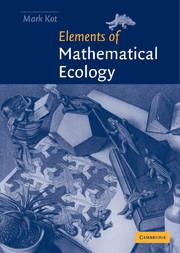Book contents
- Frontmatter
- Contents
- Preface
- Acknowledgments
- I UNSTRUCTURED POPULATION MODELS
- II STRUCTURED POPULATION MODELS
- 15 Formulating spatially structured models
- 16 Spatial steady states: linear problems
- 17 Spatial steady states: nonlinear problems
- 18 Models of spread
- 19 An overview of linear age-structured models
- 20 The Lotka integral equation
- 21 The difference equation
- 22 The Leslie matrix
- 23 The McKendrick–von Foerster PDE
- 24 Some simple nonlinear models
- 25 Two-sex models
- References
- Author index
- Subject index
25 - Two-sex models
Published online by Cambridge University Press: 05 August 2012
- Frontmatter
- Contents
- Preface
- Acknowledgments
- I UNSTRUCTURED POPULATION MODELS
- II STRUCTURED POPULATION MODELS
- 15 Formulating spatially structured models
- 16 Spatial steady states: linear problems
- 17 Spatial steady states: nonlinear problems
- 18 Models of spread
- 19 An overview of linear age-structured models
- 20 The Lotka integral equation
- 21 The difference equation
- 22 The Leslie matrix
- 23 The McKendrick–von Foerster PDE
- 24 Some simple nonlinear models
- 25 Two-sex models
- References
- Author index
- Subject index
Summary
Populations are often sexually dimorphic for demographic traits. Caswell (2001) has done a good job of highlighting some of these differences. The life expectancy of women exceeds that of men by about 10%. The life expectancy of female Belding's ground squirrels is about 25% greater than that of males (Sherman and Morton, 1984). Female black widow spiders (Deevey and Deevey, 1945) typically live 170% longer than males. However, I do not want to give the impression that females always outlive males. Males of many species of monogamous birds live longer than females (Darwin, 1871; Breitwisch, 1989), for reasons that vary from differences in natal dispersal (Greenwood and Harvey, 1982) to differences in parental investment. Differences in survivorship frequently manifest themselves as a skewed sex ratio in the population.
Some species show sex-based differences in the age of maturity. Female sperm whales attain sexual maturity at 7 to 9 years. Males may become physiologically mature at 19 years, but do not reach social maturity for 25 to 27 years (Nowak, 1991). Most organisms have sex-based differences in fecundity.
As a result, life tables and demographic models for males and for females often give different predictions. Kuczynski (1931) calculated the male and female net reproductive rates for France for 1920–1923. The male rate was 1.194 and the female rate was 0.977. If one were to follow these calculations to their logical conclusion, one would now expect France to consist entirely of men ⊨ Kuczynski attributed the difference in the rates to the skew in sex ratio caused by the First World War.
- Type
- Chapter
- Information
- Elements of Mathematical Ecology , pp. 413 - 424Publisher: Cambridge University PressPrint publication year: 2001



